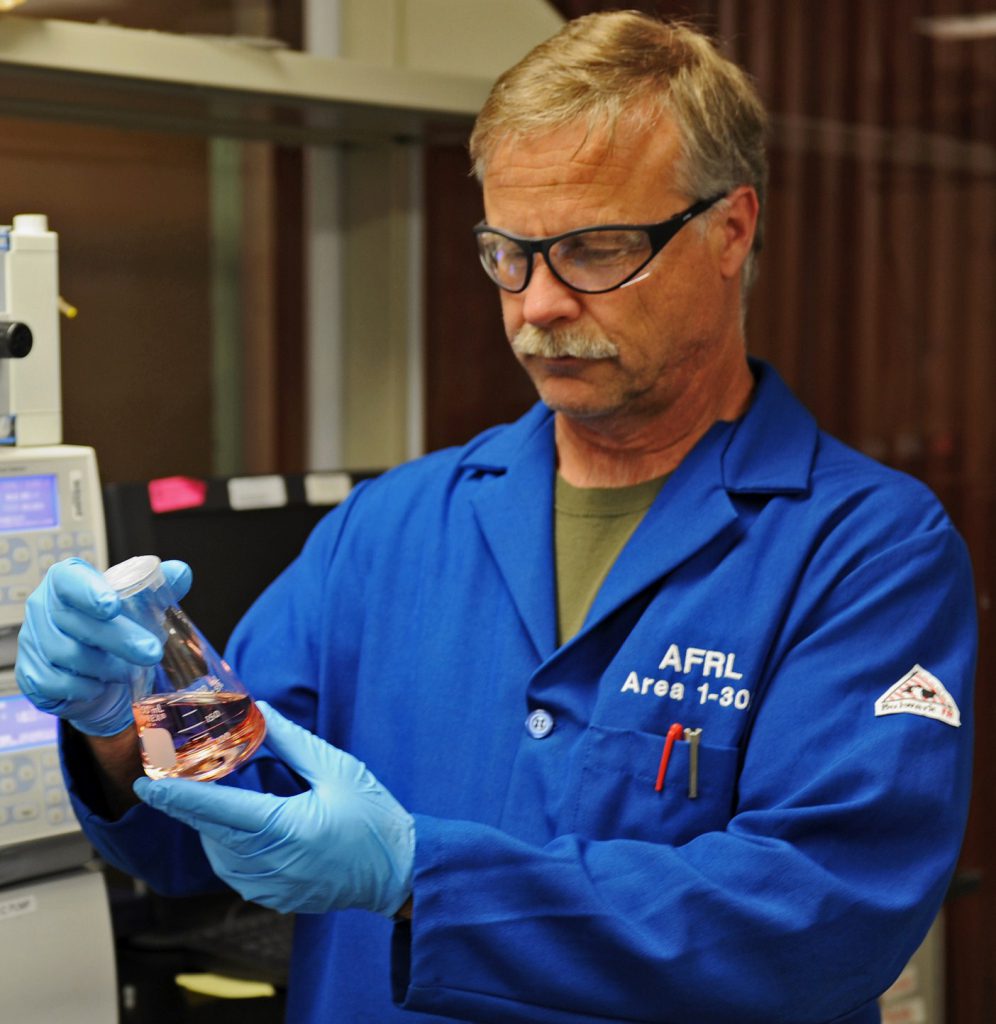Long awaited launch of NASA’s GPIM mission to use AFRL-developed propellant
ARLINGTON, Va. – NASA’s Green Propellant Infusion Mission (GPIM) launched into space on a SpaceX Falcon Heavy rocket early in the morning of June 25. GPIM will use, for the first time in space, a high-performance, environmentally benign “green” fuel developed by the Air Force Research Laboratory (AFRL). The mission will test the non-toxic, rosé-colored liquid fuel and propulsion system, which arose out of basic research (6.1) funded by the Air Force Office of Scientific Research (AFOSR), the basic research arm of AFRL, and applied research (6.2) in AFRL’s Aerospace Systems Directorate at Edwards Air Force Base.
While hydrazine, an energetic ionic liquid (EIL) fueled most U.S. space missions since the 1970s, this toxic, corrosive, flammable material fell short of providing the propulsive power required for future spacecraft systems.
In 1998, Dr. Michael Berman, a Program Manager of the Molecular Dynamics and Theoretical Chemistry program at AFOSR, funded Dr. Tom Hawkins of the Propellants Branch, Rocket Propulsion Division at AFRL’s Aerospace Systems Directorate, to find a more benign, yet powerful material to replace hydrazine as a fuel for spacecraft.
This research effort was later associated with a joint government and industry development program, the Integrated High Payoff Rocket Propulsion Technology (IHPRPT) initiative, which challenged the Department of Defense, the National Air and Space Administration and the rocket propulsion industry to double the U.S.’s rocket propulsion capability (in cost and performance).
Hawkins’ interest in EILs started early in his career when he worked on advanced propellants for the Strategic Defense Initiative in the 1980s, at Lehigh University in Pennsylvania. Knowing the untapped potential of ionic liquids to provide high energy density materials, he launched an effort to design and characterize the EIL family.
It was in 2002 when Hawkins thought, “… we were on the right track when we produced an ionic liquid monopropellant that incorporated an EIL that was investigated under our AFOSR program,” said Hawkins. “This propellant class, known as AF-M315, has an energy density close to twice that of the state-of-the-art spacecraft monopropellant, hydrazine.”
NASA’s Space Technology Mission Directorate (STMD) became a champion of the promising alternative to hydrazine in 2012, selecting Ball Aerospace & Technologies Corporation as the lead integrator for GPIM. Additional government-industry team members included AFRL, Aerojet Rocketdyne, the Air Force Space & Missile Systems Center and the NASA/Glenn Research Center.
AF-M315 provides perks for both humans and spacecraft. The non-toxic propellant promises fewer handling restrictions and preparations at launch facilities, thereby reducing time and cost. Ultimately, NASA’s new “green” fuel offers better mission performance— propelling spacecraft to travel longer distances at faster speeds with less propellant.
“It’s a win-win situation,” says Berman. “The new propellant is safer and easier to handle than hydrazine, as well as higher performing,” he asserts. Ultimately, it will enable satellites to move further using a similar amount of fuel compared to hydrazine. If successful, this mission can pave the way for wider use of this propellant in future spacecraft, and in other applications.”
GPIM is part of the Department of Defense’s Space Test Program-2 (STP-2) mission, which is managed by the U.S. Air Force Space and Missile Systems Center.
ABOUT AFOSR: The Air Force Office of Scientific Research, located in Arlington, Virginia, continues to expand the horizon of scientific knowledge through its leadership and management of the Air Force’s basic research program. As a vital component of the Air Force Research Laboratory, AFOSR’s mission is to discover, shape and champion basic science that profoundly impacts the future Air Force. Through its international enterprise AFOSR supports the Air Force science and technology community by identifying foreign technological capabilities and accomplishments that can be applied to Air Force needs.
To stay up-to-date on the latest AFOSR happenings, please join us on Facebook or follow us on Twitter, and LinkedIn.

